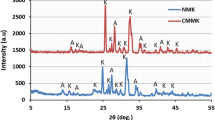Abstract
In the present study, the As(V) removal efficiency of different clay minerals was investigated as a function of solution pH, time, As(V) concentration, and temperature. Arsenic mobility was also investigated by determining the As(V) released from the loaded samples by leaching with various aqueous solutions. The kinetics of adsorption was observed to be fast and reached equilibrium within 3 h. As(V) adsorption on studied clays was pH dependent and maximum adsorption was achieved at pH 5.0. The maximum adsorption capacity was calculated by fitting the Langmuir equation to the adsorption isotherms and found to be 0.86, 0.64, and 0.52 mg As(V)/g of kaolinite, montmorillonite, and illite, respectively. The negative effect of temperature on As(V) adsorption showed the interactions to be exothermic. Based on the results, it was found that among the studied clay minerals, kaolinite was the best As(V) adsorbent and montmorillonite had strong retention capacity. The electrokinetic behavior of kaolinite and montmorillonite was modified in the presence of As(V), indicating that adsorption involves inner sphere surface complexation and strong specific ion adsorption.
Similar content being viewed by others
References
World Health Organisation (WHO), Guidelines for drinking water quality, Vol-II, Health criteria and other supporting information, 2nd Edition, Geneva (1996).
EPA, Technologies and costs for removal of arsenic from drinking water, EPA-815-R-00-028. Office of water (4606), Environmental Protection Agency, Washington, DC (2000).
W. Zhang, P. Singh, E. Paling and S. Delides, Miner. Eng., 17, 517 (2004).
D. Mohapatra, D. Mishra, G. Roy Chaudhury and R. P. Das, Separation and Purification Technol., 49, 223 (2006).
R. Naseem and S. S. Tahir, Water Res., 35, 3982 (2001).
K. G. Bhattacharyya and S. S. Gupta, Colloids and Surfaces A: Physicochem. Eng. Aspects, 277, 191 (2006).
W. E. Halter and H. R. Pfeifer, Applied Geochemistry, 16, 793 (2001).
S. Goldberg, Soil Sci. Soc. Am. J., 66, 413 (2002).
R. A. Griffin and N. F. Shimp, Attenuation of pollutants in municipal landfill leachate by clay minerals, EPA-600/2-78-157 (1978).
G. Sposito, The chemistry of soils, Oxford University Press, New York (1989).
US EPA, Treatment of arsenic residuals from drinking water removal processes, EPA/600/R-01/033, Cincinnate, OH. (2001).
A. C. Q. Ladeira and V. S. T. Ciminelli, Water Res., 38, 2087 (2004).
M. Bauer and C. Blodau, Science of the Total Environment, 354, 179 (2006).
Y. Arai, E. J. Elzinga and D. L. Sparks, J. Colloid Interface Sci., 235, 80 (2001).
R. J. Hunter, Zeta potential in colloid science, Academic press, London (1981).
Author information
Authors and Affiliations
Corresponding author
Rights and permissions
About this article
Cite this article
Mohapatra, D., Mishra, D., Chaudhury, G.R. et al. Arsenic adsorption mechanism on clay minerals and its dependence on temperature. Korean J. Chem. Eng. 24, 426–430 (2007). https://doi.org/10.1007/s11814-007-0073-z
Received:
Accepted:
Published:
Issue Date:
DOI: https://doi.org/10.1007/s11814-007-0073-z




